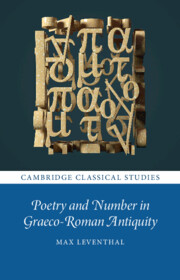Book contents
- Poetry and Number in Graeco-Roman Antiquity
- Cambridge Classical Studies
- Poetry and Number in Graeco-Roman Antiquity
- Copyright page
- Dedication
- Contents
- Acknowledgements
- Abbreviations and Editions
- Introduction Numbers Up
- Part I Counting and Criticism
- Part II Arithmetic and Aesthetics
- Conclusion Summing Up Poetry
- Bibliography
- Index
- References
Bibliography
Published online by Cambridge University Press: 05 May 2022
- Poetry and Number in Graeco-Roman Antiquity
- Cambridge Classical Studies
- Poetry and Number in Graeco-Roman Antiquity
- Copyright page
- Dedication
- Contents
- Acknowledgements
- Abbreviations and Editions
- Introduction Numbers Up
- Part I Counting and Criticism
- Part II Arithmetic and Aesthetics
- Conclusion Summing Up Poetry
- Bibliography
- Index
- References
Summary
- Type
- Chapter
- Information
- Poetry and Number in Graeco-Roman Antiquity , pp. 213 - 226Publisher: Cambridge University PressPrint publication year: 2022
- Creative Commons
- This content is Open Access and distributed under the terms of the Creative Commons Attribution licence CC-BY-NC-ND 4.0 https://creativecommons.org/cclicenses/



